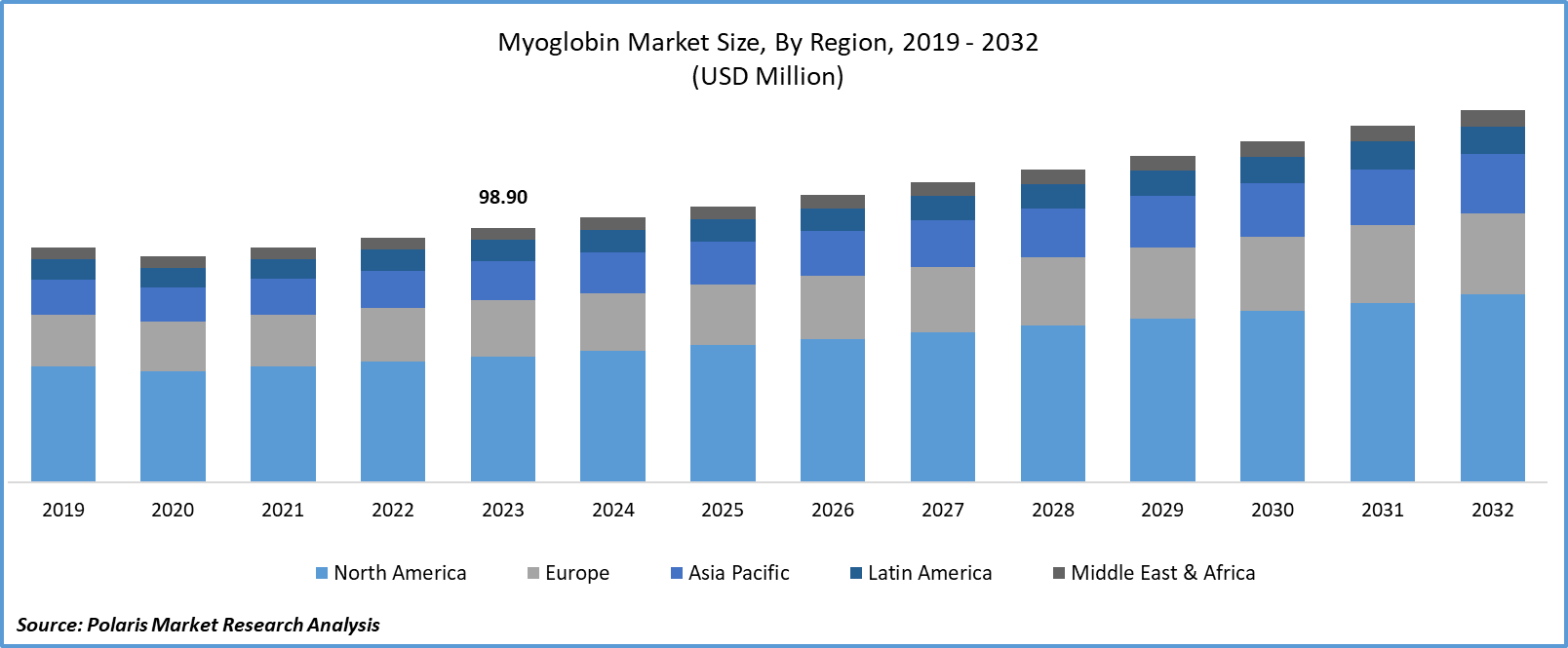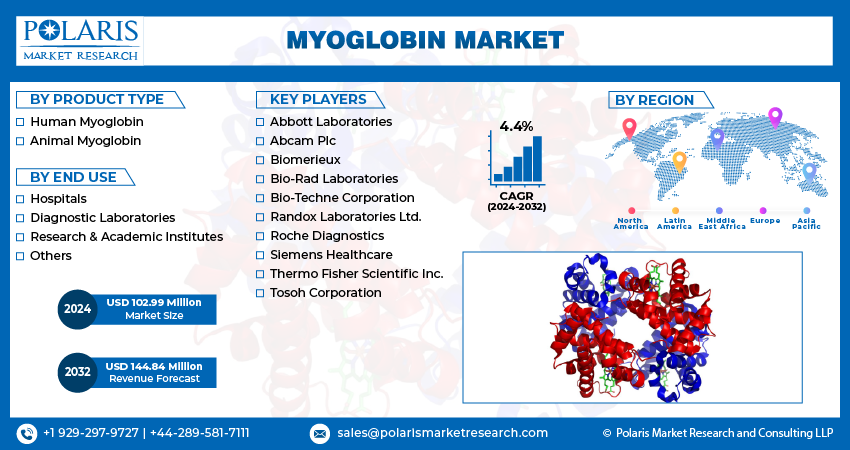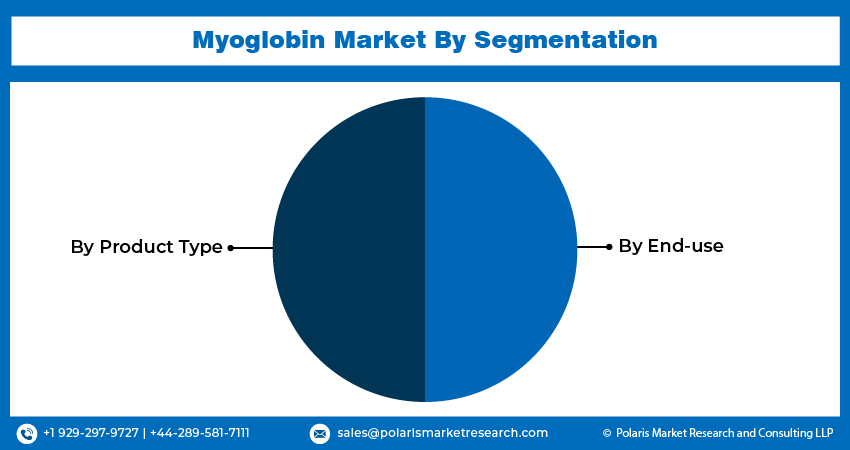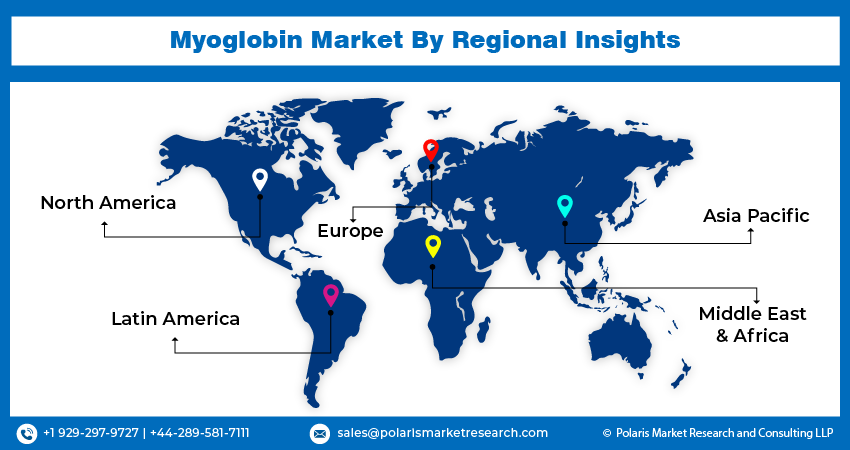
Myoglobin Market Share, Size, Trends, Industry Analysis Report, By Product Type (Human Myoglobin And Animal Myoglobin); By End Use; By Region; Segment Forecast, 2024- 2032
- Published Date:Mar-2024
- Pages: 119
- Format: PDF
- Report ID: PM4802
- Base Year: 2023
- Historical Data: 2019-2022
Report Outlook
Global myoglobin market size was valued at USD 98.90 million in 2023. The market is anticipated to grow from USD 102.99 million in 2024 to USD 144.84 million by 2032, exhibiting the CAGR of 4.4% during the forecast period.
Market Overview
Myoglobin plays a crucial role in medical diagnostics, particularly in the assessment of cardiac health. It is used as a biomarker for conditions such as myocardial infarction (heart attack) and rhabdomyolysis (muscle injury). The growing number of people undergoing cardiac surgeries across the globe and increasing knowledge and proliferation about myoglobin utility as an effective or accurate indication of left ventricular wall thickening are key factors expected to drive global market growth. Additionally, the widespread use of myoglobin as a flavor enhancer and natural colorant in meat products, sauces, and marinades, coupled with the growing popularity of processed food products like sausages, deli meats, and burgers, are further likely to have a positive impact on market's growth.

To Understand More About this Research:Request a Free Sample Report
The increasing demand for myoglobin can be attributed to the growing number of open-heart surgeries performed worldwide each year. Open-heart surgery is a common medical procedure used to treat various cardiovascular conditions, such as coronary artery disease, heart valve disorders, and congenital heart defects. During these surgical procedures, myoglobin plays a crucial role in assessing and monitoring patients' cardiac health.
- For instance, in June 2022, according to a report by the National Institute of Health, more than 2 million open-heart surgeries to treat several heart problems are performed every year across the world.
Furthermore, the growing advancements in nanomaterials and the proliferation of its ability to enhance the detection of molecular and cellular biomarkers associated with cardiovascular disease create significant growth opportunities for the market. Metallic nanomaterials and quantum dots have been widely used in the electrochemical methods for the detection of cardiac biomarkers including myoglobin, creatine kinase, and troponin, offering lucrative opportunities for the companies providing myoglobin testing products and services.
The myoglobin market experienced a notable negative impact due to the COVID-19 pandemic. Amidst the global health crisis, efforts, resources, and research attention were redirected toward addressing the immediate challenges posed by the virus. Consequently, ongoing research, clinical trials, and developmental endeavors related to myoglobin were notably hindered. Laboratories and research facilities encountered operational hurdles, including lockdowns, mobility restrictions, and supply shortages, which impeded progress in exploring myoglobin's applications and potential advancements.
Additionally, the exploration of myoglobin's applications in various fields, including biotechnology, pharmaceuticals, and food safety, drives demand for research tools, reagents, and analytical instruments. Ongoing research efforts aimed at understanding myoglobin's role in physiology, pathology, and therapeutic interventions contribute to market demand.

Growth Factors
Increasing prevalence of cardiovascular diseases and rising aging population to drive market growth
The increasing prevalence of cardiovascular diseases (CVD) and the rising aging population are significant growth factors for the Myoglobin market. With the aging population, there is a higher prevalence of CVD, such as heart attacks, heart failure, and coronary artery disease. These conditions often lead to myocardial injury, resulting in the release of myoglobin into the bloodstream. As a result, the demand for myoglobin testing as a biomarker for cardiac injury increases, driving market growth.
Myoglobin testing plays a crucial role in the early detection and diagnosis of myocardial injury, aiding in prompt medical intervention and treatment. As a result, the demand for myoglobin testing kits and assays rises, contributing to market growth. As healthcare infrastructure improves and access to medical services expands, more individuals, especially the aging population, undergo diagnostic tests for cardiovascular diseases. Healthcare facilities, including hospitals, clinics, and diagnostic laboratories, invest in myoglobin testing equipment and reagents to meet the growing demand for cardiac biomarker testing, further driving market growth.
For instance, according to a report published by the World Heart Federation in April 2023, over half a billion people worldwide are affected by cardiovascular diseases, and it accounts for more than 20.5 million deaths in 2021 globally.
Growing research & development activities to spur market growth
Major healthcare and pharmaceutical companies are increasingly investing in research and development activities to explore the new properties and potential uses of myoglobin, which leads to the creation of new applications and products of myoglobin, driving market growth. Furthermore, companies are focusing on the development of new technologies facilitating the early detection and treatment of several health conditions, which is positively impacting the market.
Restraining Factors
Lack of skilled professionals and stringent regulations to restrain market growth
The lack of skilled healthcare professionals to conduct myoglobin biomarkers tests, especially in developing or under-developed economies, and the presence of stringent government regulations regarding the clinical trials and development of myoglobin are the factors restraining the global market growth.
Report Segmentation
The market is primarily segmented based on product type, end use, and region.
|
By Product Type |
By End Use |
By Region |
|
|
|
To Understand the Scope of this Report:Speak to Analyst
By Product Type Insights
Human myoglobin segment accounted for the largest market share in 2023
In 2023, the human myoglobin segment accounted for the largest market share due to the increased proliferation of myoglobin as a very crucial or sensitive marker for certain injuries in muscles, and it also becomes a potential marker for various problems, including heart attack in people with regular chest pain. Additionally, myoglobin has proven to have enzymatic functions for the decomposition of the bioactive NO to nitrate and enhances mitochondrial respiration in the human body.
The animal myoglobin segment is expected to grow at the fastest growth rate. This growth is attributable to increasing demand and consumption of meat products such as poultry and beef and growing people's awareness about the incidences of foodborne illnesses that fuel the need for myoglobin in meat products to ensure their safety and quality. For instance, as per a report by the Centers for Disease Control and Prevention, it is estimated that every year, around 48 million people get affected due to foodborne illnesses, and about 3000 people die each year due to the illness.
By End Use Insights
The hospital segment is expected to witness the fastest-growing CAGR during the forecast period.
The hospital segment is expected to witness the fastest-growing CAGR during the forecast period. This is due to the availability of the latest and most advanced myoglobin testing technologies in hospitals and the rapid adoption of point-of-care testing devices that allow for accurate and timely diagnosis. With the growing importance of myoglobin tests for diagnosing conditions, including muscle-related disorders, heart attacks, and renal dysfunction, hospitals across the globe are increasingly incorporating accurate myoglobin assays for monitoring patient conditions and providing them with reliable treatment.

Regional Insights
North America region dominated the largest market share in 2023
In 2023, the North American region dominated the largest market share. The region’s dominance is accelerated by the growing incidence of heart-related disorders and the presence of well-established healthcare infrastructure with a favorable environment for the adoption and development of myoglobin-based technologies. The significant presence of the senior population in the region who are more prone to muscle-related conditions and awareness among healthcare professionals about the importance of myoglobin testing in muscle-related diseases further contribute to the region’s growth.
The Asia Pacific region is anticipated to emerge as the fastest growing region with a healthy CAGR, owing to increased consumption of meat products as a result of rising population and changing consumer dietary habits. With consumers becoming more aware and conscious of their health and dietary preferences, the demand for myoglobin-rich meat products is increasing rapidly because it plays a crucial role in muscle function.
The Asia Pacific region is witnessing an increase in the prevalence of cardiovascular diseases, attributed to factors such as changing lifestyles, urbanization, dietary habits, and aging populations. As cardiovascular diseases become more prevalent, the demand for diagnostic tests, including myoglobin testing, rises, driving the market growth. Many countries in the Asia Pacific region are investing in healthcare infrastructure development, including the expansion of hospitals, clinics, and diagnostic laboratories. This expansion enhances access to medical services and diagnostic testing, contributing to the growth of the Myoglobin market as more individuals undergo cardiac biomarker testing.

Key Market Players & Competitive Insights
The myoglobin market is moderately fragmented and is anticipated to witness competition due to several players' presence. Major companies are competing on various factors such as product innovation, regulatory compliance, and investments in research & development activities. Key players are focusing on several expansion strategies, including partnerships, collaborations, strategic alliances, and mergers, to gain a competitive edge over the competitors and capture a significant market share.
Some of the major players operating in the global market include:
- Abbott Laboratories
- Abcam Plc
- Biomerieux
- Bio-Rad Laboratories
- Bio-Techne Corporation
- Randox Laboratories Ltd.
- Roche Diagnostics
- Siemens Healthcare
- Thermo Fisher Scientific Inc.
- Tosoh Corporation
Recent Developments
- In February 2023, Aethera Biotech and Ergo Bioscience partnered to upscale the production of plant proteins from plant cell cultures. Ergo Bioscience utilizes plant cell suspension culture to produce myoglobin and casein. The collaboration aims to enhance biotechnological processes for producing these plant-based proteins.
Report Coverage
The myoglobin market report emphasizes on key regions across the globe to provide better understanding of the product to the users. Also, the report provides market insights into recent developments, trends and analyzes the technologies that are gaining traction around the globe. Furthermore, the report covers in-depth qualitative analysis pertaining to various paradigm shifts associated with the transformation of these solutions.
The report provides detailed analysis of the market while focusing on various key aspects such as competitive analysis, product type, end use, and their futuristic growth opportunities.
Myoglobin Market Report Scope
|
Report Attributes |
Details |
|
Market size value in 2024 |
USD 102.99 million |
|
Revenue forecast in 2032 |
USD 144.84 million |
|
CAGR |
4.4% from 2024 – 2032 |
|
Base year |
2023 |
|
Historical data |
2019 – 2022 |
|
Forecast period |
2024 – 2032 |
|
Quantitative units |
Revenue in USD million and CAGR from 2024 to 2032 |
|
Segments covered |
|
|
Regional scope |
|
|
Competitive Landscape |
|
|
Report Format |
|
|
Customization |
Report customization as per your requirements with respect to countries, region and segmentation. |
FAQ's
The Myoglobin Market report covering key segments are product type, end use, and region.
The global myoglobin market size is expected to reach USD 144.84 million by 2032
Myoglobin market exhibiting the CAGR of 4.4% during the forecast period.
North America is leading the global market
key driving factors in Myoglobin Market are Growing research & development activities
